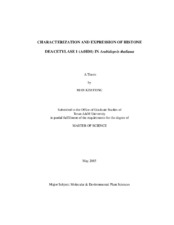| dc.description.abstract | The reversible process of histone acetylation and deacetylation is an important mechanism of epigenetic regulation in the control of gene expression and chromatin structure. In general, histone acetylation is related to gene activation, whereas histone deacetylation is associated with transcriptional gene silencing and maintenance of heterochromatin. A large number of histone deacetylases (HDACs), the enzymes that catalyze the reaction of histone deacetylation, have been identified in plants and other eukaryotes, and they were found to play crucial roles in plant growth and development. In Arabidopsis thaliana, histone deacetylase 1 (AtHD1) is a homolog of Saccharomyces cerevisiae Rpd3 that is a global transcriptional regulator. Downregulation of AtHD1 in transgenic Arabidopsis results in histone hyperacetylation and induces a variety of phenotypic and developmental defects, suggesting that AtHD1 is also a global regulator of many physiological and developmental processes. To characterize the expression pattern and distribution of AtHD1 in cells, the subcellular location of AtHD1 was determined by monitoring the expression of an AtHD1-GFP fusion protein in a transient expression assay and in transgenic Arabidopsis.The results show that AtHD1 is localized in the nucleus and appears to be excluded from the nucleolus. The histone deacetylase activity of AtHD1 was studied in an in vitro assay using radiolabeled histone peptides as a substrate. Recombinant AtHD1 produced by bacteria demonstrated a moderate but significant HDAC activity, whereas that produced by the baculovirus expression system did not have activity. This suggests that AtHD1 may require other cofactors or association with other proteins, rather than post-translational modifications, in order to have full HDAC activity. To study the possible interactions of AtHD1 with other proteins, a recombinant AtHD1 protein with two units of c-myc epitope fused to its C-terminus was expressed in transgenic Arabidopsis. We attempted to isolate proteins interacting with AtHD1 by co-immunoprecipitation (Co-IP). However, in the first few trials of Co-IP, a lot of contaminating proteins were present in the eluent along with the recombinant AtHD1-cmyc protein. Improvements in the experimental conditions are required for further investigation. | en |


